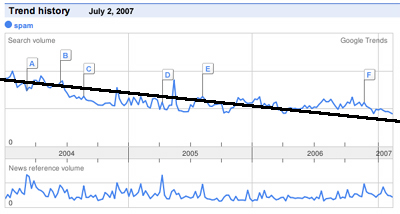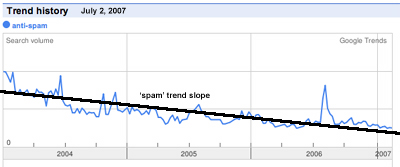Is Spam on the Run?
Has the incidence of spam gone up or down over the past three years?
Surely, it's gone down? With the June arrest of alleged spam king, Robert Soloway, the recent flurry of product releases to filter image spam, the release of two Brockmann & Company reports on email, and the more sophisticated filter and challenge-response appliances now available, spam ought to have declined. Ok, maybe our reports didn't have much impact on the incidence of spam, but the other facts are indisputable.
Let's review the data. Since we don't have Spam Index results for the past three years, we'll check out the use of Google Trends as the lead tool in this report.
 Google Trends showed the number of searches on the phrase 'spam' here on the left. The blue line in the upper graph shows the search volumes for the past three years. The graph along the bottom shows the volume of news with that key phrase.
Google Trends showed the number of searches on the phrase 'spam' here on the left. The blue line in the upper graph shows the search volumes for the past three years. The graph along the bottom shows the volume of news with that key phrase.
To give it a scale, the Overture network estimated the searches in January 2007 at 51,000/month.
This same downward slope over the past three years as presented in the trend history above is also present in the search phrase 'anti-spam' as shown below.

How does the Google Trend approximate user experience?
I have used the idea of instantaneous relative page competition (the number of search results) to argue for the importance of SIP, the weighting of the risks associated with various VoIP attacks. This is the first time that we've studied the question using Google Trend, which is quite different since it's search frequency over time.
So that means, that since 2004, there have been 50% fewer searches on anti-spam (see height of the black line in the lower figure at the left and compare to the height at the right) and 50% fewer searches on spam. These are global searches too, since the typical Google Trend includes the top 10 cities most frequently searching the term.
It seems on the face of it, that the spam abatement programs of the past three years (CAN-SPAM, Microsoft et al's aggressive legal campaigns, black listing and other techniques) are resulting in fewer searches. So, if search frequency can approximate the user experience, (users search more often when it's a problem and less often when it's not a problem) then spam really is on the run.
This post has already been read 0 times!
Edit
